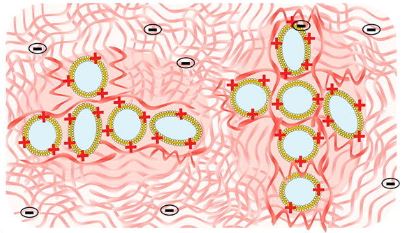Céline JAUDOIN, Isabelle GRILLO, Fabrice COUSIN, Maria GEHRKE, Malika OULDALI, Ana-Andreea ARTENI, Luc PICTON, Christophe RIHOUEY, Fanny SIMELIERE, Amélie BOCHOT, Florence AGNELY
Mixtures of hyaluronic acid (HA) with liposomes lead to hybrid colloid–polymer systems with a great interest in drug delivery. However, little is known about their microstructure. Small angle neutron scattering (SANS) is a valuable tool to characterize these systems in the semi-dilute entangled regime (1.5% HA) at high liposome concentration (80 mM lipids). The objective was to elucidate the influence of liposome surface (neutral, cationic, anionic or anionic PEGylated), drug encapsulation and HA concentration in a buffer mimicking biological fluids (37 °C). First, liposomes were characterized by SANS, cryo-electron microscopy, and dynamic light scattering and HA by SANS, size exclusion chromatography, and rheology. Secondly, HA-liposome mixtures were studied by SANS. In HA, liposomes kept their integrity. Anionic and PEGylated liposomes were in close contact within dense clusters with an amorphous organization. The center-to-center distance between liposomes corresponded to twice their diameter. A depletion mechanism could explain these findings. Encapsulation of a corticoid did not modify this organization. Cationic liposomes formed less dense aggregates and were better dispersed due to their complexation with HA. Liposome surface governed the interactions and microstructure of these hybrid systems.
Hybrid systems combining liposomes and entangled hyaluronic acid chains: Influence of liposome surface and drug encapsulation on the microstructure
Céline Jaudoin, Isabelle Grillo, Fabrice Cousin, Maria Gehrke, Malika Ouldali, Ana-Andrea Arteni, Luc Picton, Christophe Rihouey, Fanny Simelière, Amélie Bochot, Florence Agnely, Journal of Colloid and Interface Science 628 Part B (2022) 995-1007.



